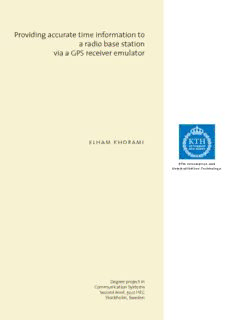
Providing accurate time information to a radio base station via a GPS receiver emulator PDF
Preview Providing accurate time information to a radio base station via a GPS receiver emulator
Providing accurate time information to a radio base station via a GPS receiver emulator ELHAM KHORAMI KTH Information and Communication Technology Degree project in Communication Systems Second level, 30.0 HEC Stockholm, Sweden KTH Royal Institute of Technology version: 2.1 Kunglia Tekniska Högskolan Date: 2013-02-10 Providing accurate time information to a radio base station via a GPS receiver emulator Elham Khorami <khorami@kth.se> 2013.02.10 Master thesis report Project performed in the GPS RBS system I&V department at Ericsson Examiner: Gerald Q. Maguire Jr. Supervisors: Kjell Fyrvall and Torbjörn Hansson School of Information and Communication Technologies KTH Royal Institute of Technology Stockholm, Sweden Abstract In recent years, there has been a significant increase in the use of Global Positioning Satellite system (GPS) technology, consequently the usage of GPS receivers has increased. These GPS receivers can be used as a synchronization source for radio base stations by generating precise 1 pulse per second signals and providing National Marine Electronics Association (NMEA) data. The prototype developed in this thesis, implements a GPS receiver emulator to emulate a GPS receiver which is to be used for radio base station synchronization. Hardware and software have been used to generate the NMEA messages and to generate a precise 1 pulse per second signal. A graphical user interface (GUI) has been created in order to allow the operators of the emulator to input various parameters to the system used to emulate a GPS receiver. Using this emulator avoids the need for expensive GPS receivers and their connection to an antenna with a good view of the GPS satellites. More importantly, this GPS receiver emulator makes it easier to set up a lab environment for testing different situations with regard to signaling with NMEA data between the emulated GPS receiver and the radio base station equipment that is under test. For example, this allows tests involving incorrect NEMA messages or non-once per second pulses. i Sammanfattning De senaste åren har det skett en significant ökning av användandet av GPS teknik; följdaktligen har användandet av GPS mottagare ökat. GPS mottagare kan användas som en synkroniseringskälla för radiobasstationer genom att generera exakt 1 puls per sekund och därmed förse NMEA datan. Prototypen som utvecklats i detta examensarbete, implementerar en GPS emulator för att erbjuda en effektiv lösning till att emulera en GPS mottagare som används för synkronisering av basstationer. Olika hårdvara och mjukvara har använts för att simulera NMEA meddelanden och för att generera en precis 1 puls per sekund signal. Ett grafiskt gränssnitt (GUI) har utvecklats för att tillåta användaren av emulatorn att mata in olika parametrar till systemet som används för att emulera GPS mottagaren. Användandet av den här emulatorn tar bort behovet av dyra GPS mottagare, och gör det enklare att sätta upp en labbmiljö för testandet av olika situationer med hänsyn till signalering mellan 1 puls per sekund och NMEA datan av den simulerade GPS mottagaren och basstationshårdvaran som testas. iii Acknowledgment I would thank my Ericsson supervisors Kjell Fyrvall and Torbjörn Hansson for providing the opportunity to perform my Master’s thesis project in Ericsson in Kista (Sweden) and in addition I want to thank them for all the technical assistance, suggestions, and guidance during the thesis project. I would also like to thank my KTH examiner, Gerald Q. Maguire Jr., for providing such thorough support throughout the thesis. I would like to mention that it was clear that Prof. Maguire really made an effort to carefully read the entire thesis and absorb the concepts, and helped me to improve my thesis through his comments and ideas. Thanks for your help! I would also like to thank my thesis colleague Ashar Waseem who always worked hard and helped me in different parts of the project. Special thanks to James Powell, who amongst other friends here in Stockholm, helped me to improve my thesis with intelligent comments. Lastly I would like to express my gratitude to my family in Iran, who despite the distance, always showed unconditional support during my education here in Sweden. Special thanks to Sarwarul Islam Rizvi for showing me his friendship throughout the master’s program. v Table of Contents Abstract ................................................................................................................................ i Sammanfattning ................................................................................................................. iii Acknowledgment ................................................................................................................ v Table of Contents .............................................................................................................. vii List of Figures .................................................................................................................... ix List of Tables ..................................................................................................................... xi List of Acronyms and Abbreviations ............................................................................... xiii 1 Introduction .................................................................................................................. 1 1.1 Introduction to the problem and initial goals ........................................................1 1.2 Overview of thesis .................................................................................................2 1.2.1 Short introduction to GPS ..............................................................................2 1.2.2 Main Goals .....................................................................................................4 1.2.3 Proposed solution ...........................................................................................4 1.3 Structure of the planned thesis ..............................................................................5 2 Background .................................................................................................................. 7 2.1 GPS Parts...............................................................................................................7 2.1.1 GPS receivers and their applications .............................................................7 2.2 1 Pulse Per Second ................................................................................................8 2.3 NMEA 0183 ..........................................................................................................8 2.3.1 General Introduction to NMEA 0183 ............................................................8 2.3.2 NMEA Sentence Format ................................................................................9 2.4 Available GPS receiver simulators in the market ...............................................10 2.4.1 Software simulators .....................................................................................10 2.4.2 Hardware simulators ....................................................................................11 2.4.3 Comparing available simulators with our GPS emulator ............................11 2.5 Synchronization using GPS .................................................................................11 2.5.1 Technologies utilizing synchronization .......................................................11 2.5.2 RBS Synchronization ...................................................................................12 3 Hardware used in the project ..................................................................................... 15 3.1 Atmel STK 500 development board ....................................................................15 3.2 Reasons for selecting this specific hardware .......................................................17 4 Software Approach .................................................................................................... 19 4.1 NMEA implementation .......................................................................................20 4.1.1 NMEA message generation .........................................................................21 4.1.2 NMEA messages ..........................................................................................25 4.1.3 Transferring NMEA messages to the RBS ..................................................33 4.1.4 Control over sending NMEA messages .......................................................33 4.1.5 Receiving information from RBS ................................................................34 4.2 Control Interface .................................................................................................37 4.2.1 GUI features .................................................................................................41 4.2.2 Serial Port features .......................................................................................43 4.2.3 Code description ..........................................................................................43 4.3 Pulse per Second Generator ................................................................................46 5 Analysis ..................................................................................................................... 49 5.1 Outputting NMEA message ................................................................................49 5.2 1 pulse per second test result ...............................................................................50 5.3 Testing the whole prototype ................................................................................51 5.4 Testing the GPS receiver emulator with a GSM RBS ........................................55 vii
Description: